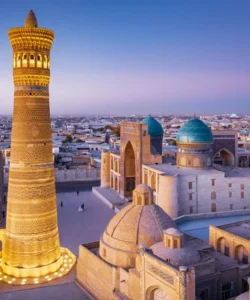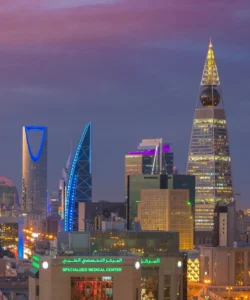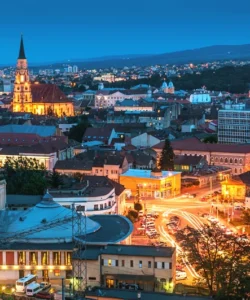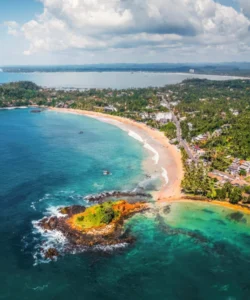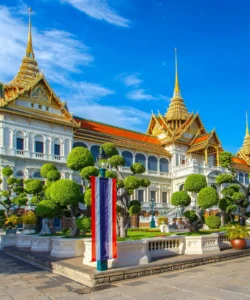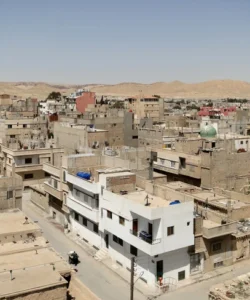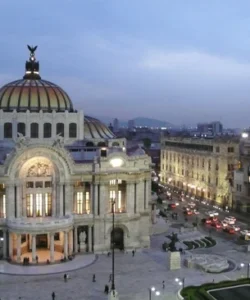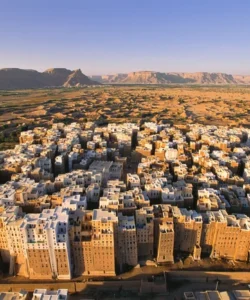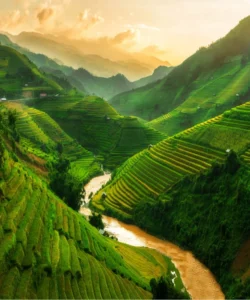North Macedonia, officially the Republic of North Macedonia, is a landlocked country in the Balkan Peninsula in Southeast Europe. Known for its mountainous landscapes, ancient sites, Ottoman-era architecture, and a rich cultural tapestry woven from Slavic, Ottoman, and other influences, it offers a fascinating blend of history and nature.
![]()
Area and Population:
North Macedonia covers an area of approximately 25,713 km² (9,928 sq mi). As of early 2025, its population is estimated to be around 1.83 million inhabitants.
Capital:
The capital city of North Macedonia is Skopje.
Major Cities:
Besides Skopje, other major cities include Bitola, Kumanovo, Prilep, and Ohrid.
Language:
The official language of North Macedonia is Macedonian. Albanian is also widely spoken, particularly in the western parts of the country, and is co-official in some municipalities. English is increasingly understood and spoken, especially among younger generations and in tourist areas.
Currency:
The official currency of North Macedonia is the Macedonian Denar (MKD).
Religion:
The dominant religion in North Macedonia is Orthodox Christianity, with the majority of the population identifying as Macedonian Orthodox. There is a significant minority of Muslims, primarily among Albanians and Turks. Smaller communities of other Christian denominations and other religions also exist.
Attractions and Wonders:
- Ohrid and Lake Ohrid: A UNESCO World Heritage site, Lake Ohrid is one of Europe’s oldest and deepest lakes, renowned for its crystal-clear waters and unique endemic species. The town of Ohrid itself is a charming historic center with numerous medieval churches (e.g., St. John at Kaneo, St. Panteleimon and Plaošnik), ancient ruins, and a fortress.
- Matka Canyon, near Skopje: A breathtaking natural gorge with a stunning turquoise river, medieval monasteries, and hidden caves (Vrelo Cave, one of the deepest underwater caves in the world), popular for kayaking, boat trips, and hiking.
- Old Bazaar (Čaršija), Skopje: One of the largest and oldest bazaars in the Balkans, with Ottoman-era mosques, hammams (bathhouses), caravanserais, and artisan shops, offering a vibrant atmosphere.
- Macedonia Square and Stone Bridge, Skopje: The main square in Skopje, featuring numerous monuments (part of the “Skopje 2014” project) and connected to the Old Bazaar by the historic Stone Bridge over the Vardar River.
- Millennium Cross, Vodno Mountain, Skopje: One of the largest crosses in the world, located on Vodno Mountain overlooking Skopje, accessible by cable car and offering panoramic city views.
- Heraclea Lyncestis, near Bitola: An ancient Macedonian city founded by Philip II of Macedon, with impressive Roman ruins, including a well-preserved theater and stunning mosaics.
- Pelister National Park: Located in the Baba Mountain range, known for its glacial lakes (“Pelister’s Eyes”), rich biodiversity, and opportunities for hiking and skiing.
- Kokino Megalithic Observatory: An ancient archaeological site dating back nearly 4,000 years, believed to be an astronomical observatory, a unique prehistoric monument.
- Bigorski Monastery (St. John the Baptist), near Debar: A stunning medieval monastery famous for its intricate wooden iconostasis (altar screen) and beautiful natural surroundings.
- Mavrovo National Park: The largest national park in North Macedonia, home to Mount Korab (the country’s highest peak), a large artificial lake, and a popular ski resort.
- Šar Mountain National Park (Šar Planina): A large mountain range shared with Kosovo and Albania, known for its high peaks, glacial lakes, and biodiversity.
Architecture:
North Macedonia’s architecture is a compelling mix of historical influences:
- Ancient & Roman: Evident in archaeological sites like Heraclea Lyncestis and Stobi, with remnants of theaters, basilicas, and mosaics.
- Byzantine: Numerous medieval churches and monasteries (especially in Ohrid and rural areas) showcase Byzantine architectural elements, often with distinctive domes and rich frescoes.
- Ottoman: Predominant in Skopje’s Old Bazaar and parts of other cities (Bitola, Prilep), featuring mosques, hammams (Turkish baths), bazaars, and traditional houses with courtyards.
- Neo-Classical & Baroque: Some late 19th and early 20th-century buildings in Bitola and parts of Skopje.
- Yugoslav Modernism/Brutalism: Functionalist and often stark concrete structures from the Yugoslav era, particularly in Skopje, built after the 1963 earthquake.
- “Skopje 2014” Project: A controversial urban renewal project in Skopje’s city center that introduced a neoclassical/baroque aesthetic with numerous new statues, monuments, and facades.
- Traditional Rural: Stone and timber houses found in mountainous and rural villages.
Roads:
North Macedonia has an improving, though still developing, road network. Major arteries are generally in good condition, but secondary roads can vary.
- Motorways (Avtopat – A-roads): An expanding network of motorways connects major cities (e.g., Skopje to Veles, Skopje to Gostivar/Tetovo, Skopje to the Serbian border). These are generally well-maintained and typically have tolls.
- Main Roads (Magistralni Puti – M-roads): A comprehensive network of main roads connects towns and regions. Quality varies; some sections are excellent, while others can be winding, narrow, or in need of repair, particularly in mountainous areas.
- Regional and Local Roads: Smaller roads in rural areas can be unpaved or poorly maintained.
- Mountain Roads: Roads through mountainous regions (e.g., to national parks) can be challenging, with sharp turns and steep inclines, and may require caution, especially in winter due to snow and ice.
- Signage: Road signs are generally clear, in Macedonian (Cyrillic) and often with Latin script and English translations.
Driving is a good way to explore the country, but be prepared for varied conditions outside of the main motorways.
Hotels:
North Macedonia offers a range of accommodation options, from international standard hotels to charming boutique properties and guesthouses.
- International Chains: Skopje, and to a lesser extent Ohrid, have international hotel brands (e.g., Marriott, Best Western).
- Boutique Hotels: Especially in the Old Bazaar of Skopje and the old town of Ohrid, charming boutique hotels offer character and local flair, often housed in traditional buildings.
- Standard Hotels: A good selection of mid-range hotels can be found in major cities and tourist destinations.
- Guesthouses (Apartments/Sobi): Many locals rent out private rooms or apartments, especially in Ohrid, offering an authentic and often affordable experience.
- Mountain Lodges: In national parks like Mavrovo and Pelister, offering accommodation for nature enthusiasts and skiers.
- Hostels: Available in major cities and popular backpacker destinations.
Restaurants and Cuisine:
North Macedonian cuisine is a delicious blend of Balkan, Mediterranean, and Ottoman influences, known for its hearty dishes, fresh vegetables, grilled meats, and flavorful spices.
- Tavče Gravče: Often considered the national dish, it’s a traditional baked bean dish, slow-cooked in an earthenware pot, usually with paprika, mint, and sometimes smoked meat.
- Ćevapi/Kebab: Small, grilled minced meat sausages, served in flatbread (lepinja) with chopped onions and often ajvar or kajmak.
- Ajvar: A popular relish made from roasted red peppers, often with eggplant, used as a spread or side dish.
- Sarma: Minced meat and rice wrapped in pickled cabbage or vine leaves, slow-cooked.
- Pastrmajlija: A traditional bread pie, topped with cubed meat and often an egg, resembling a long, open-faced pizza.
- Shopska Salata: A refreshing salad with diced tomatoes, cucumbers, onions, and bell peppers, topped with grated white brined cheese.
- Kajmak: A rich, creamy, clotted dairy product, often served with bread or grilled meats.
- Pindjur: A relish similar to ajvar, but usually chunkier and with tomatoes.
- Makedonska Salata: A hearty salad with roasted peppers, garlic, and cheese.
- Burek: A flaky, savory pastry made with thin layers of dough, filled with minced meat, cheese, spinach, or potatoes. Popular as street food.
- Mekici: Fried dough, often served with cheese or jam.
- Various Grilled Meats: Popular throughout the country, including pork, lamb, and chicken.
- Desserts:
- Tulumba: Fried dough soaked in syrup.
- Baklava: Layers of phyllo pastry with nuts and syrup.
- Kompot: Fruit compote.
- Drinks:
- Rakija: A strong fruit brandy (plum, grape, pear), widely produced and consumed.
- Macedonian Wine: Wine production is growing, especially in the Tikveš region, known for indigenous varieties like Vranec (red) and Smederevka (white).
- Mastika: An anise-flavored alcoholic drink, similar to ouzo.
- Boza: A non-alcoholic, fermented drink made from millet.
- Turkish Coffee: Strong and traditionally prepared.
Dining experiences range from traditional “kafanas” (taverns) serving local dishes and grilled meats to more modern restaurants in major cities offering international cuisine. Hospitality is deeply ingrained in Macedonian culture.

